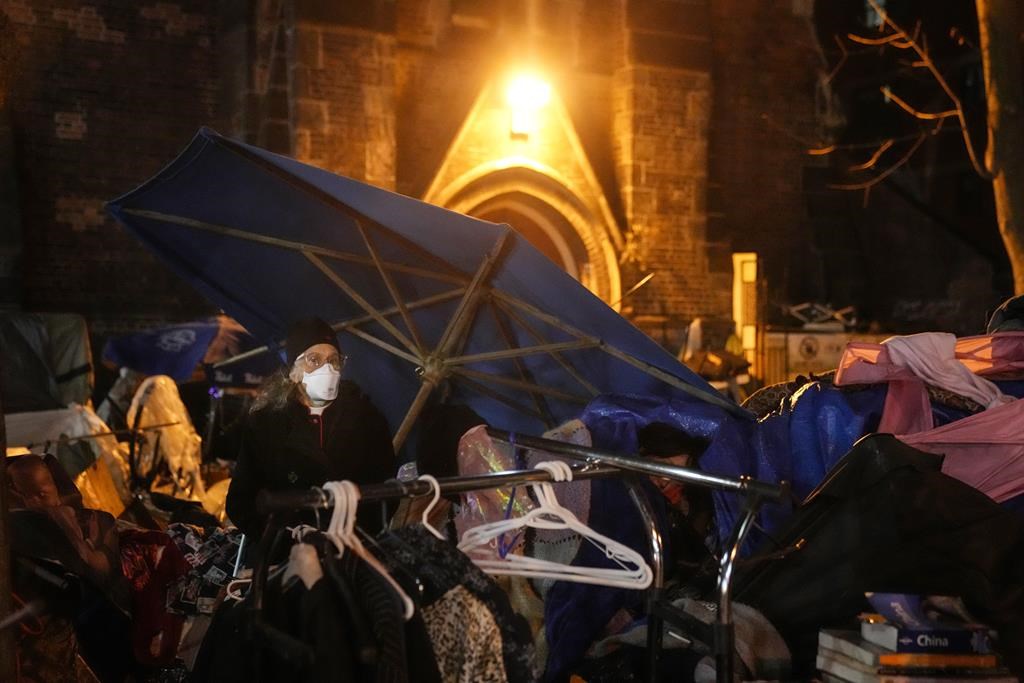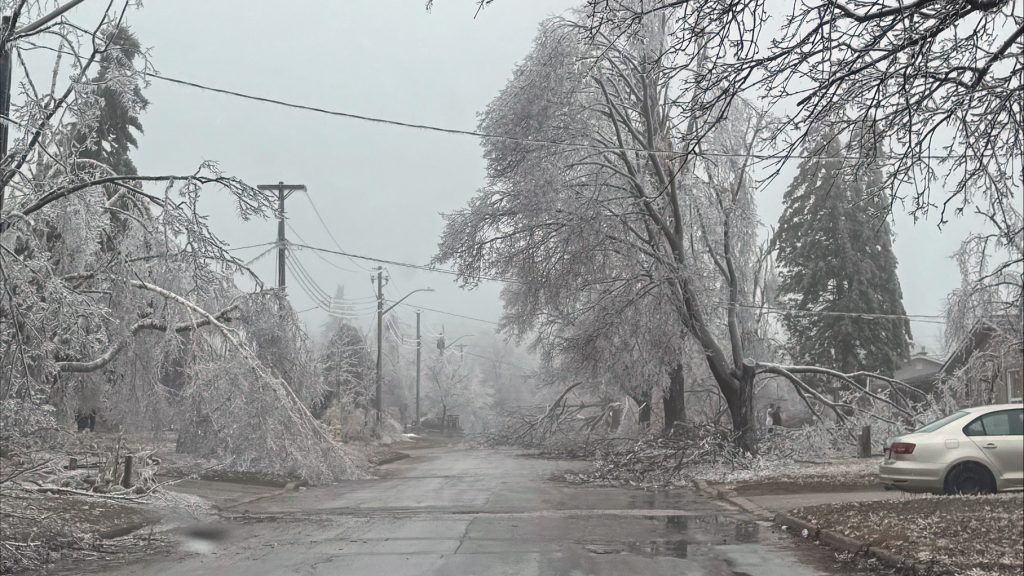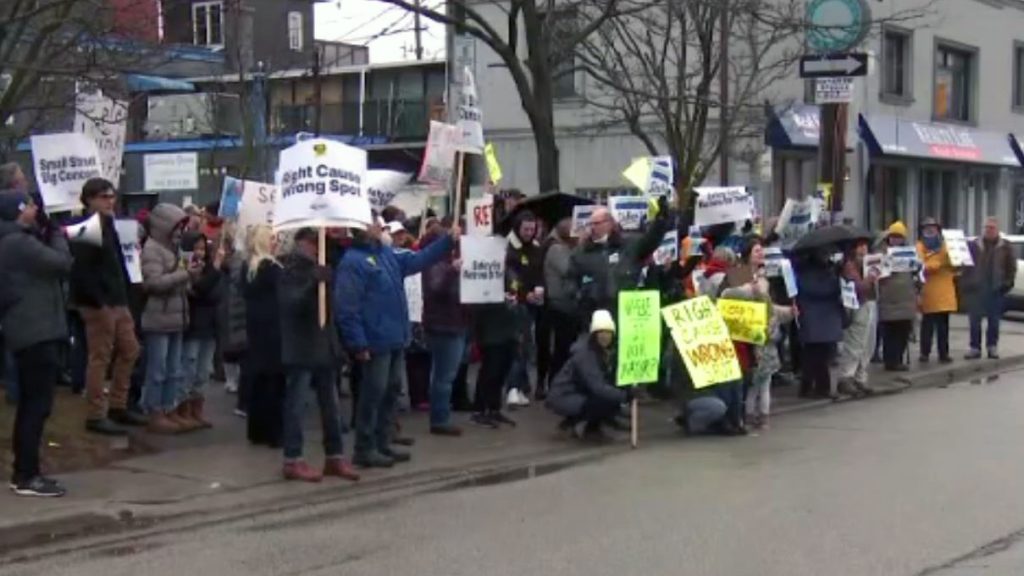Toronto’s homeless residents and frontline workers brace for bitter winter

Posted December 16, 2023 4:00 am.
Last Updated December 16, 2023 7:39 am.
In warmer weather, Jamie Lee Pauk is usually on the move searching for food or a job. But as winter closes in, she’s mostly staying close to a downtown Toronto encampment squeezed into a churchyard lot off the sidewalk of a busy downtown street.
“With this cold specifically, I’ve been quite still. I can’t even function,” says Pauk, wearing an overcoat and multiple sweaters as temperatures hovered around 0 C. “Some days it’s unbearable and then other days, you just hunker down.”
Pauk was the last remaining resident of a homeless encampment outside St.-Stephen-in-the-Fields Anglican Church as of last week. Most of it was cleared by City of Toronto crews over a day in late November as temperatures dipped below freezing.
Despite trespass notices and threats of arrest, Pauk refuses to budge. She says leaving the encampment would mean leaving friends, community and nearby support she’s depended on since July 2022. At St.-Stephen, she has close access to hot meals, drop-in services, showers, laundry and sometimes even movies. She knows she can warm up in the nearby convenience store when the cold becomes unbearable.
“St.-Stephen was the one thing like, man, if I didn’t have that, I probably wouldn’t have survived the winter before,” she says.
The housing crisis in Canada’s most populous city saw unprecedented numbers of people experiencing homelessness last winter, with many sheltering in public spaces including libraries and transit stations and vehicles. Health care, outreach and faith workers are bracing for what they say could be even worse conditions this winter as they attempt to fill gaps they say should be addressed by multiple levels of government.
The decision to clear the city-owned portion of the St.-Stephen encampment was “a tool of last resort” to address “combustible and hoarded materials” that posed a risk to public safety, the city said. Rows of large concrete blocks and a metal fence now block the space where up to 25 people at a given time lived in makeshift shelters surrounded by belongings including coat racks, books and bikes.
Some residents left ahead of the clearing, while the city said nine people accepted offers of shelter space with individualized support plans. Head of the church Rev. Canon Maggie Helwig says residents forced to move were offered spots at converted hotels but those spots tend to be a revolving door due to strict policies that can lead to eviction.
The city began using hotels as homeless shelters in the early days of the pandemic to augment spots and accommodate public health advice for physical distancing.
Police and shelter providers evicted residents at a number of COVID-19 shelters last winter as the properties reverted back to hotel operations, and Pauk says she’d already been evicted from two for missing bed checks. The city is moving forward with a plan to phase out the expensive, temporary sites, with most leases ending April 30, 2024.
“It’s not housing. A lot of them are probably going to be back on the street very soon,” Helwig says of those residents.
The City of Toronto’s winter services plan, which outlines measures for people experiencing homelessness, adds 180 shelter beds to its more than 9,400 existing spaces, and four warming centres that will open to 180 occupants when temperatures dip below -5 C — lowered from last year’s -15C threshold. There are also three 24-hour respite sites that can accommodate 310 people.
But even the city acknowledges the plan “may not be sufficient to address the increasing demand for shelter and housing.” City data shows an average of nearly 300 people a day were turned away from Toronto’s shelter system in October — a 56 per cent increase from the same time last year.
Unhoused asylum seekers federal responsibility
The crisis worsened in late May, when city officials began sounding the alarm over a rise in refugee claimants seeking shelter beds, noting the numbers had grown by 500 per cent over the previous 20 months. Hundreds were forced to sleep on the streets as Toronto referred asylum seekers to federal programs.
Immigration minister Marc Miller said in November that the federal government had offered Toronto $5 million to help accommodate asylum seekers at a cavernous exhibit and community centre on the grounds of Exhibition Place. The city said it did not receive such an offer, and said it also did not get any of the nearly $100 million the feds promised in July. In November, an asylum seeker was found dead in a Mississauga encampment tent, leading Ottawa to pledge another $7 million to open a reception centre at nearby Toronto Pearson Airport.
Community outreach worker Diana Chan McNally advocated for the reception centre but says it won’t help claimants who have already arrived in Toronto.
The city argues that unhoused asylum seekers are a federal responsibility adding to housing demand after the government waived certain eligibility requirements for visitor visas.
“We are still basically covering the costs of sheltering asylum seekers on behalf of the federal government who are making announcements of money that has actually never materialized,” she says.
Cold injuries and hypothermia
Chan McNally says much of her outreach involves giving sleeping bags and hand-and-foot warmers to newcomers unprepared for winter but donations have dropped drastically amidst the cost-of-living crisis.
“Teaching basic survival skills like how to stay warm however you can is now a part of my work, which it never was before.”
Research by Dr. Carolyn Snider, chief of the emergency department at St. Michael’s Hospital, found cold-weather visits by homeless people to her downtown ER jumped 68 per cent over the previous five winters. She says it’s jumped further this fall, estimating that she encounters five to 10 people on average in the waiting area when she arrives for her morning shifts.
That includes an influx of newcomers since the summer, and Snider says she’s concerned about “cold injuries and hypothermia” for those not used to Canadian winters. Cities across the country have reported a rise in encampment fires, some of them involving deaths.
Snider echoed calls for increased cooperation, resources and investments from all levels of government to address root causes of homelessness, suggesting improvements to addiction and mental health services and preventative care.
Rev. Helwig says turkey dinner donations around the holiday season often go to waste when cash donations are more useful year-round.
“But really, what people need to do is create more political pressure because nobody much cares about a lot of homeless people struggling to survive,” she says.
“Until we have a lot of people who really vocally care about this and talk to their political representatives at all levels constantly, we’re not going to see the kind of change we need to see.”








